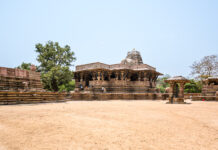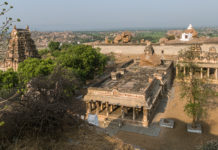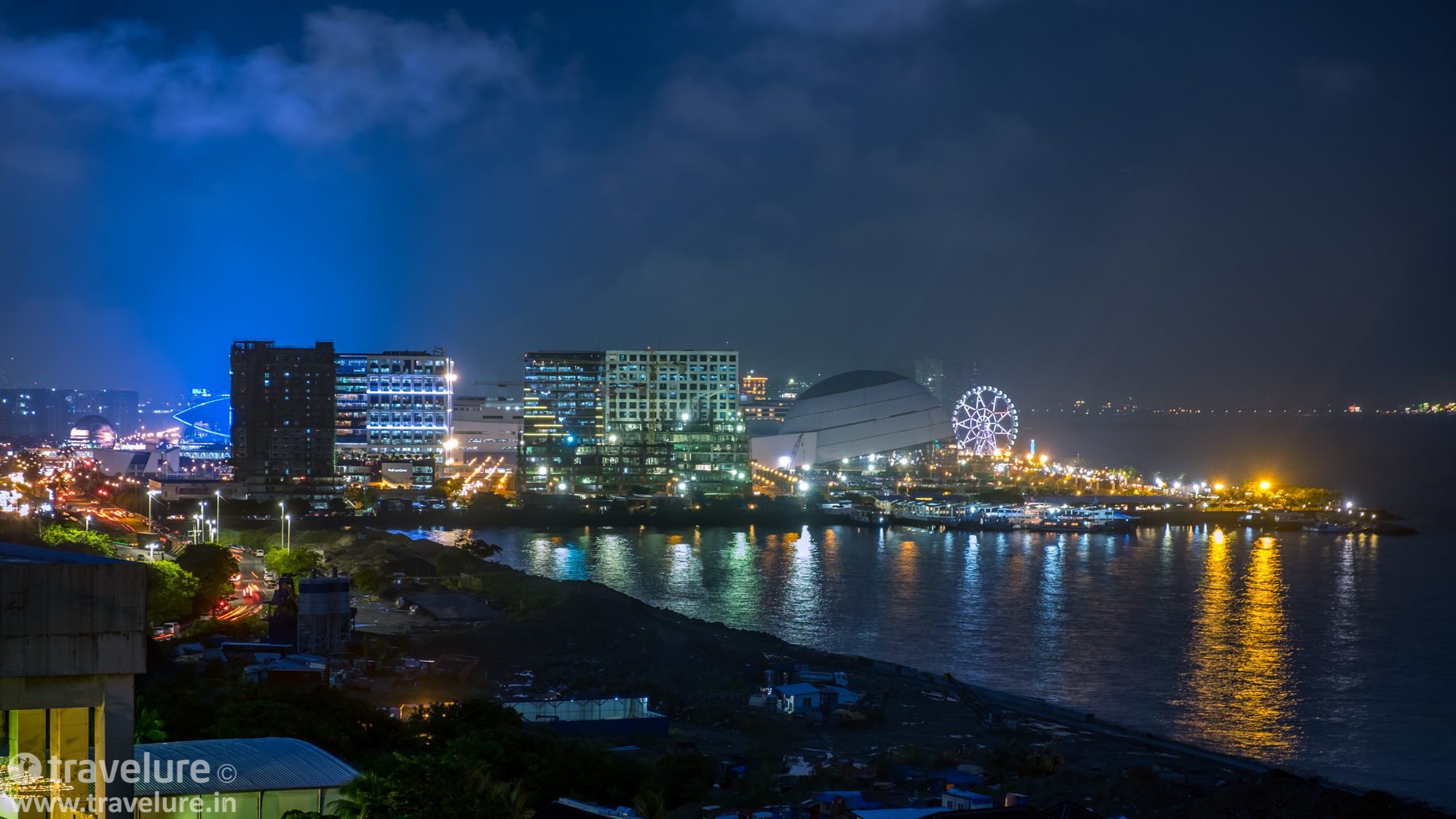Outlook Traveller – India’s leading Travel Magazine – has carried this story in its July 2018 issue.
Cyprus – Beyond the Mediterranean Hues
As I nervously got out of the car, a genial, portly man in uniform hurried forth to welcome me uttering a reassuring ‘I know all about you’. It was well past 5 in the evening and I had just reached the archaeological site of Palaipafos (‘old Pafos’ in Greek) in Kouklia Village, Paphos. During our conversation, I learnt he was the man-in-charge of this UNESCO World Heritage site. This site was about 14 km from Paphos city and was one of the three that have jointly been inscribed on the UNESCO list in 1980 – the other two being in the city, close to Paphos harbour.

While the museum here closes at 5 pm during spring, apparently someone from the tourism department had called him to accommodate this photographer from India who was keen to check out the 3200-year old mosaic masterpieces. As I exhaled a deep sigh of relief, I could palpably feel my admiration for the department going up.
Discovering Heritage
Palaipafos, one of the most important ancient city-kingdoms of Cyprus, is linked to the Aphrodite Cultural Route. While the archeological excavations here are still going on, what has already been unearthed is remarkable. From the excavated ruins replete with 2-feet thick walls and gothic columns, some of the 12th-century artifacts and mosaics have been moved into the museum on site.

One such piece was a mosaic rendition of scantily clad Aphrodite – the Greek Goddess of Love. As a photographer, I know my task is to create the illusion of the third dimension in a two-dimensional frame. Looking at this artwork, I was mesmerised by the finesse of the artist who faced a daunting task to conceive and create the third dimension in a jigsaw 2D medium. The task required both, perfection in planning as well as execution. It was not just about assessing the direction of light and pressing the trigger. It was about assessing it, and then conceiving hundreds of tiny pieces – each to perfectly reflect the subtle hues that would ultimately provide the illusion of that elusive third dimension. The body contours and the natural fall of the drape were just too perfect!

Realisation Dawns
It seemed the rare art of mosaics was extremely advanced during the 12th-century BCE Cyprus. My visit to the sister site of Palaipafos the same morning, the one near the Paphos harbour, had brought me face-to-face with another set of brilliantly conceived mosaic floors. It is believed that site was an ancient home of a wealthy Cypriot from that era. The site was an aggregation of multiple mosaic collages of the Greek god of wine – Dionysus.

Besides the varied manifestations of Dionysus, the other mosaics on this site ranged from geometric patterns to animals, hunting scenes to elaborate war scenes, and more. Amongst the animals depicted there, the ones that intrigued me the most were a peacock and a tiger. It made me wonder if the artisans who created these masterpieces were from the distant lands of South or South-east Asia!
Of Talent and More
Seeing more heritage gems from Cyprus, it increasingly became clear that over the centuries, Cypriots have demonstrated amazing talent. They not only showcased talent in their three-millennia old mosaics but also via the painted churches from the medieval Byzantine era.

Some of these Byzantine and post-Byzantine churches lie sprinkled across the Troodos mountain range in Central Cyprus. In 1985, UNESCO had accorded World Heritage Site status to a set of 10 churches from this region, which date between 11th and 15th centuries CE.
Rich Hues of Heritage
Architecturally, I found these structures simplistic, almost inconspicuous-looking, donning a steeply sloping tiled roof like a normal village house. But the highly refined decorations and murals inside were in stark contrast to their unassuming exteriors. Additionally, my guide pointed out, the painted murals have a wealth of dated inscriptions – an important factor that helped establish the chronology of these Byzantine paintings.
These murals are a splash of golds, rich-blues, deep-reds, and yellows and they depict the local manifestations of the various saints, Virgin Mary and Jesus. Some of these, especially the ones inside the Church of St. Nicholas of the Roof, betray a strong stylistic similarity between Cypriot and Western Christian art.

The rich decorations were not limited to just the UNESCO-inscribed churches. I saw similar ancient paintings and murals in churches spread across Lefkara and Larnaca too. The art in these churches was equally stunning. All in all, it provided the perfect inspiration for the photographer in me.
Surprise, Surprise!
Ironically, before my visit to Cyprus, my vision of this island nation was limited to some stunning beaches overlooking the predictable deep turquoise of the Mediterranean and some buzzing pubs and hangouts. Even in my wildest dreams, I had not imagined that I would find such gorgeous heritage masterpieces here. But then, shouldn’t travelling to a new destination always be a colourful riot of discovery?
Want more of Cyprus? Go to Postcards

The Information:
Getting There:
While there are 12 airlines that can take you to Cyprus (Emirates, Gulf Air, Ukraine Intl, Qatar, Aeroflot, Alitalia, BA, Swiss Air, KLM, Lufthansa, Austrian, and EgyptAir), none of the airlines currently fly directly to Cyprus. But, the 3 most convenient connections are Emirates, Qatar, and Gulf Air. The average return ticket price would be around Rs.45,000. The most convenient connections are to Larnaca International Airport (LCA). Since the entire island is 240-km x 100-km, it is not difficult to get around and see the various attractions. Albeit a little expensive, taxis are the most convenient mode of transport. All the same, if you would like to save on transport, here is a helpful link to book your itinerary by bus – Cyprus by Bus
Where to Stay:
While there are numerous options to stay all across Cyprus, here is a shortlist to help you get started.
Paphos: Aliathon Holiday Village, Yeroskipou, Cyprus; 4-Star; average room tariff €250 per night
Some of these sites have been shared in my article – Postcards
Nicosia: Hilton Cyprus, 98 Arch. Makarios III Avenue, Nicosia 1077, Cyprus; 5-Star; average room tariff €315 per night
Larnaca: Palm Beach Hotel and Bungalows, Dhekelia Rd, Larnaca 6303, Cyprus; 4-Star Deluxe; room tariff starts from €170 per night
Ayia Napa: Limanaki Beach Hotel, 1st October, Ayia Napa 5330, Cyprus; 4-Star; room tariff starts from €220 per night
What to See & Do:
Nea Pafos: Part of a UNESCO World Heritage site, famous for its stunning mosaics. The site is still under excavation and is about 200 mt. from Paphos Harbour
Mythical Birthplace of Aphrodite (Petra tou Romiou): A short scenic stop, said to be the mythical birthplace of the Greek goddess of love. Part of one of the most scenic coastlines in Cyprus. Located around 25-km from Paphos
Sanctuary of Aphrodite, Palaipafos: Located in Kouklia Village, the archaeological site of Palaipafos was one of the most important city-kingdoms of Cyprus. It was the first Cypriot site to be included in the World Heritage List of UNESCO in 1980. Located about 28-km from Paphos Harbour.
Painted Churches of Troodos Region: Sprinkled across the areas of Pitsilia, Solea, and Marathasa, a cluster of 10 Byzantine and Post-Byzantine Churches were collectively inscribed on to the UNESCO World Heritage list in 1985 for their stunning paintings and murals that throw a light on the chronology of spread of Christianity in Cyprus.
Nissi Beach, Ayia Napa: The sandbar of this spectacular beach extends 500-mt into the Mediterranean to take you to an islet. If you choose to wade through the water to get to this islet, the water is just waist-high.
Neolithic Settlement of Choirokoitia (local: Khirokitia): Inscribed in the UNESCO World Heritage list, this site was inhabited from 7th to 5th Millennia BCE. It is about 33-km from Larnaca Harbour.
For many more posts from across the globe, navigate through Cyprus by Bus




















